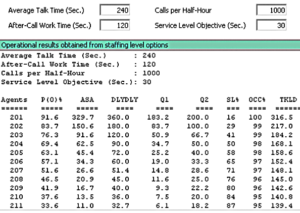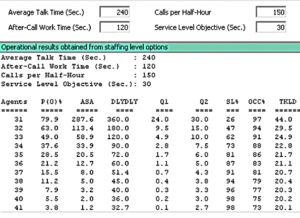The Pooling Principle in Contact Centers is a vital principle for everyone in the Center to understand from Director to Agent. Because it helps us avoid making errors in how we look at and interpret productivity.
This article is part of our Contact Center Management Series — a collection of articles that bring together practical guidance and insights to help Contact Centers run better and deliver stronger results.
Here’s a scenario for the morning
It’s Monday morning and the calls are pouring in.
But you planned well and you’ve got the right Agent capacity in place.
For the morning interval of 9:00AM to 9:30AM, here’s what your stats look like using a simple Erlang C calculator:
Your Service Level objective is 80/30.
And based on a Talk Time of 4 minutes, an After Call Work time of 2 minutes and a volume of 1,000 calls, you require 209 Agents to login to capacity so that you can achieve your 80/30.
Thank you Erlang C and all good.
A quick note on my Erlang C images
I’ve put in screenshots from my personal Erlang C calculator to show these calculations.
Though these screenshots may be slightly hard to read.
If you know how to use an Erlang C calculator (that matters) and you have access to one (that matters too), I recommend you do these calculations on your own calculator.
On the other hand, if you don’t know how to use an Erlang C calculator or you don’t have access to one, you can still benefit from this article.
That’s why I put the figures in the narrative.

Now let’s look at the Occupancy stats for this interval
In this same scenario, you can see that the Occupancy Rate – which is an outcome or result – stands at 96%.
That’s really busy.
Simply put – that means during this 30 minute interval, your Agents are talking or doing their after call work for 29 minutes.
That means that they will experience only 1 minute of Available Time over the course of that half hour (not much).
What about the # of Calls Handled per Agent?
Well – if we are receiving 1,000 calls distributed across 209 Agents that works out to an average of 4.8 calls per Agent for that interval (using simple math).
Here’s a scenario for the same Center – for the afternoon
In this Center, the Call Load drops significantly in the afternoon.
For the afternoon interval of 4:00PM to 4:30PM, here’s what your stats look like using our Erlang C calculator:
Your Service Level objective remains at 80/30 (that should be obvious).
Based on a Talk Time of 4 minutes, an After Call Work time of 2 minutes (kept at the same levels as the morning interval for purposes of simplicity) and a volume of 150 calls, you require 35 Agents to login to capacity so that you can achieve your 80/30.
Thank you Erlang C and all good.

But notice how Occupancy has changed
You can see that the Occupancy Rate – which is an outcome or result – has fallen from its morning 9:00AM – 9:30AM level of 96% down to a 4:00PM – 4:30PM level of 86%.
Even though we are still meeting the same Service Level of 80/30.
What about the # of Calls Handled per Agent?
Using simpe math – with 150 calls across distributed across 35 Agents – that works out to an average of 4.3 calls per Agent for that interval.
This 4.3 average calls per Agent in the afternoon interval compares to the 4.8 average calls per Agent in the morning interval.
So using # of Calls Handled per Agent as a ‘productivity measure’ we can see that productivity declined.
But please be very careful. We must put this observation into context.
Don’t start telling everyone that the Agents in the afternoon are less productive. Let’s see what is going on.
So are the afternoon Agents less productive than our morning Agents?
On an individual Agent level the answer is no.
The Agents who are logged into capacity in the afternoon interval of 4:00PM to 4:30PM are operating in a smaller pool of Agents.
Or put another way, they are working in a pool of 35 Agents in total.
Compare and contrast that with the morning interval. Remember that from 9:00 – 9:30 in the morning we needed 209 Agents in the pool to meet Service Level.
So the morning interval requirement of 209 Agents is significantly more than the afternoon interval requirement of 35 Agents.
And this is where the Pooling Principle in Contact Centers comes into the picture.
What the Pooling Principle in Contact Centers teaches us
At the same Service Level achievement (in our example that’s 80/30) smaller pools of Agents have lower Occupancy rates as compared to larger pools of Agents.
Occupancy fluctuates with group size – even when meeting the same Service Level objective interval after interval.
When I teach this principle for certification exam purposes I like to say:
Bigger pool – bigger Occupancy…Smaller pool – smaller Occupancy. Even when achieving the same Service Level requirement.
This is a mathematical reality of the inbound Contact Center.
Something that everyone from senior management through to individual Agents should know.
So what does this mean for Contact Center management?
In all cases, measuring Agents on # of Calls Handled is incorrect – from a mathematical standpoint, an operations standpoint and a people management standpoint.
There are operational realities at work over which Agents don’t have control.
And one of those realities is the Pooling Principle.
Agents working in a bigger pool are going to be busier.
Because the Pooling Principle teaches us that bigger groups have ‘bigger’ Occupancy (or higher Occupancy). If you look at their call handling they will be handling more calls.
But not because they’re more productive. They’re just busier.
While Agents working in a smaller pool are going to be less busy.
Because the Pooling Principle teaches us that smaller groups have ‘smaller’ Occupancy (or lower Occupancy). If you look at their call handling numbers they will be handling fewer calls.
Would it be fair to say that the Agents working from 9:00AM to 9:30AM are more productive than the Agents working from 4:00PM to 4:30PM?
No – it wouldn’t. I hope you can see why. Agents don’t control the mathematical outcomes of working in larger or smaller groups. They simply log in to capacity when they are scheduled or asked to do so.
And yet around the world, in too many Centres, Agents are still judged or evaluated by how many calls they take.
Sometimes people tell me – yes Dan I get it. But I still target Agents on the quantity produced.
But you can’t say you ‘get it’ and then turn around and not ‘use it’ – it’s contradictory. And just wrong.
Another strategic learning about the Pooling Principle in Contact Centers is this one
If you are operating with large pools of Agents across many intervals – keep your eye on the Occupancy rates they are experiencing.
The purpose is not to judge them – but to help them.
It’s proven that when Agent Occupancy hits 88% and above for long periods of time (day after day, week after week, month after month), burn-out sets in.
Understanding of the Pooling Principle also helps with queue design – for example whether to split a large queue into smaller queues – or combine smaller queues into a larger queue.
What about call handling normalization?
The content in this article is considered to Contact Center Operations 101 material. It is fundamental – not advanced.
But with that said, this type of knowledge is not intuitive.
And if you’re in a management role, you owe it to yourself, your people and your organization to learn it.
For the advanced reader – yes there are normalization techniques that help you understand the ‘rate’ of call handling across groups with different Occupancy rates.
It’s called the True Call per Hour normalization technique and I wrote about that aspect in this article:
When someone know the Pooling Principle it well it means
That they also know and understand:
- How Occupancy and Service Level interrelate
- How to use Erlang C
- Why # of Calls Handled per Agent is an incorrect metric to target
- Interval based staffing & scheduling
- What happens when Occupancy goes too high
All of these are fundamental aspects of Contact Center management.
Thank you for reading!
I regularly share stories, strategies, and insights from our work across Contact Centers, Customer Service, and Customer Experience. If this resonates, I’d love to stay connected.
You can drop me a line anytime, or subscribe via our website.
Daniel Ord
[email protected]
www.omnitouchinternational.com



